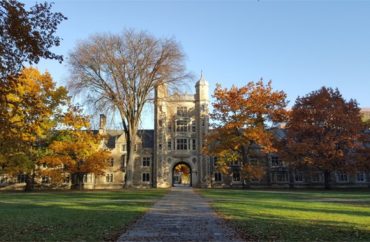
Many universities have renamed buildings that students and staff have found offensive for a variety of reasons, and now the University of Michigan is one step closer to joining them.
President Mark Schlissel this week published an official list of principles that will be used when a request is made to his office to rename a campus building at the 200-year-old public institution.
“Students and others on a number of college campuses nationally have, in recent years, questioned the practice of naming buildings after those whose actions or views, in their own times, supported slavery or discrimination,” he stated. “Should a member of the university community advocate for a building name to be reconsidered, the university now has a process for researching and considering such a request.”
The announcement comes roughly six months after a University of Michigan regent donated $3 million to help build a new multicultural center, a gift that would have included his and his wife’s namesake. But students voiced anger that the building would be renamed after a white man, and the gift was rescinded.
The donation “was removed three months later after the Board of Regents approved renaming the building Bernstein-Bendit Hall and UM students balked that the name would replace the name of William Monroe Trotter, a racial justice activist whose name is on the multicultural facility. It is the only building on campus that is named after an African-American,” the Detroit News reports.
After news of the renaming principles circulated, some students praised the development.
“A white man almost had his name on a multicultural building,” sophomore Ayah Issa told the Michigan Daily. “It is a big step out of the gray area for the University to implement this policy.”
“It would be amazing to have more buildings named after African Americans and women,” she added. “… [N]ow would be a good time to reexamine if the University’s historical roots match up with fair representation.”
MORE: Fox News founder’s name ripped off Ohio U. building right after president announces removal
MORE: Students want building renamed because it honors a guy named … ‘Lynch’
As for the new naming principles, they are:
• The principle of interpretation: When a name is selected for a building or portion of a building, the obligation to explain and interpret that name does not end at the conclusion of the naming ceremony. Indeed, it is not only good stewardship on behalf of those after whom spaces are named, but also an affirmative obligation of the pedagogical principle to continuously interpret — and if necessary reinterpret — the names and the stories behind the names of university facilities. … In some cases, changing a name may be less important than providing adequate interpretation of it.
• The principle of due diligence: In approaching a naming decision, the university owes it to itself and to succeeding generations to do substantial research into the name, and that this research should be focused on the public record.
• The principle of commitment: In general, the university community makes a significant commitment to an individual or a family when it names a space after a person. This applies both to spaces named for donors and for others. In some cases involving donors, this naming is regulated by a binding legal agreement.
• The principle of revision: The exciting and important thing about the study of history is that both the materials for and the understanding of the past are constantly changing. At a research university, historical scholars must lead the way in producing these new historical discoveries and interpretations. If these new understandings, from time to time, produce controversy over space names, that is not an unnatural thing.
• The principle of historical and institutional context: It is easy to blame those in the past for lacking the knowledge, wisdom and values that we seem to possess. … An institution of knowledge must leave room for an essential truth: The search for new knowledge through research is messy.
• The principle of consistency: There have been more than 16,000 faculty members in the history of the university; many more staff members, 14 presidents. Why some are honored with space names and others are not is a major question about our past. … Space names also tend to reflect the early composition of the university: an all-male student body until 1870 and an overwhelmingly male faculty until the mid-20th century.
• The principle of contemporary effect: Honorifics given at one time can have significantly different effects on community members at another and these, too, are worthy of consideration.
The final decision on any building name change would rest with the Board of Regents, the university states.
MORE: Now it’s the University of Oregon’s turn to rename ‘offensive’ buildings
Like The College Fix on Facebook / Follow us on Twitter







Please join the conversation about our stories on Facebook, Twitter, Instagram, Reddit, MeWe, Rumble, Gab, Minds and Gettr.